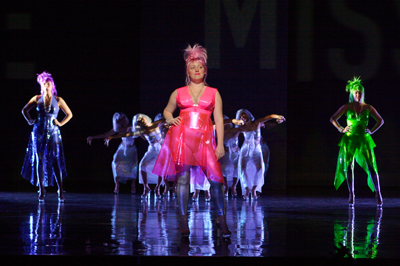28 Oct 2007
The Coronation of Poppea — English National Opera
For some seasons now, ENO has expressed a commitment to reinforce the role of dance within opera.

For some seasons now, ENO has expressed a commitment to reinforce the role of dance within opera.
Having collaborated in the past with choreographers including Mark Morris, the company is now two thirds of the way through a Monteverdi opera cycle in collaboration with Chinese-American director Chen Shi-Zheng, the Orange Blossom Dance Company from Indonesia, and the early-music specialist conductor Laurence Cummings. A precedent was set by the opening opera of the cycle in spring 2005 — an Orfeo of spectacularly hypnotic, fluid beauty.
The company début of rising British singer Kate Royal as Poppea was an additional selling point for this second opera in the cycle. She's a glamorous singer, with a polished sultriness in her low-lying soprano, but the stage directions prevented her from painting a convincing character portrait; she spent much of the first act perched high on the deck of Nerone’s luxury yacht (yes, there was a surreal marine theme to the production, with much of the action apparently taking place underwater) which made her untouchable and aloof. Projected images on the backdrop reinforced this idea; she was an icon, virtually a graven image to be worshipped. Despite Royal’s natural poise and elegance, there was little sense of Poppea’s earthy sexiness nor of her calculating ambition.
Lucy Crowe (Drusilla) and Robert Lloyd (Seneca) had an easier time of it, and managed to make something believable of their roles; Christopher Gillett’s Arnalta looked (intentionally) ridiculous but sang very beautifully at times.
Otherwise, the cast was a bit weak and underpowered. It is, perhaps, unfair to blame the singers for this; Monteverdi operas were not designed for a space the size of the Coliseum. Tim Mead's Ottone started off with that slightly yelpy sound which countertenors get when they over-project (though he sorted this out by the second half). Anna Grevelius, as Nerone, sang very sweetly but didn't project any masculinity either vocally or physically - certainly not enough to convince as an egomaniacal ruler. Doreen Curran’s Ottavia had considerable vocal presence, but her characterisation wasn’t aided by the fact that the director had her languishing on top of what looked like a large white pumpkin at the bottom of the sea. Indeed, the costumes and props seemed incidental to the opera, and at times even a hindrance. Sometimes it was more like a fashion show, with wacky structured haute-couture costumes which made me wonder whether we'd accidentally strayed into the Zandra Rhodes-designed Aida a few weeks early.
 Katherine Manley (Fortune) / Sophie Bevan (Love) / Jane Harrington (Virtue) and Orange Blossom Dance Co
Katherine Manley (Fortune) / Sophie Bevan (Love) / Jane Harrington (Virtue) and Orange Blossom Dance Co
The Indonesian dance troupe were usually incidental to — indeed, often distracting from — the action rather than providing the unifying, mesmerising presence they supplied to last year’s wonderful Orfeo. The production did have moments of real beauty - like the dancers in the dragonfly costumes rising slowly into the air during "Pur ti miro". And there was great beauty in the music — is it even possible not to make this score beautiful? Laurence Cummings really understands Monteverdian line and seemed to have taken considerable trouble to share this with the cast.
But compared with Orfeo, with its sense of "flow" and constantly visually-arresting use of colour and movement, this Poppea staging was scrappy and disappointing. In truth, the biggest problems were the failure to communicate the humanity of the characters, and the fundamental sense of division between the musical performance and the visual spectacle. Chen Shi-Zheng has shown himself to be yet another director who allows his personal vision for a production to take priority over the work being performed. ENO still has him lined up to direct Il ritorno d’Ulisse and I really hope he engages more with that than he seems to have done with Poppea.
Ruth Elleson © 2007